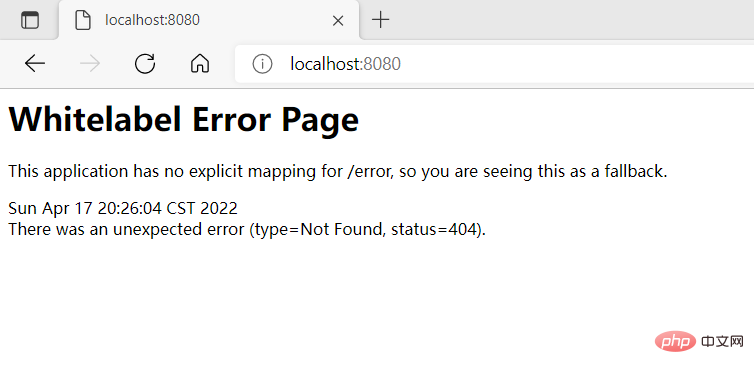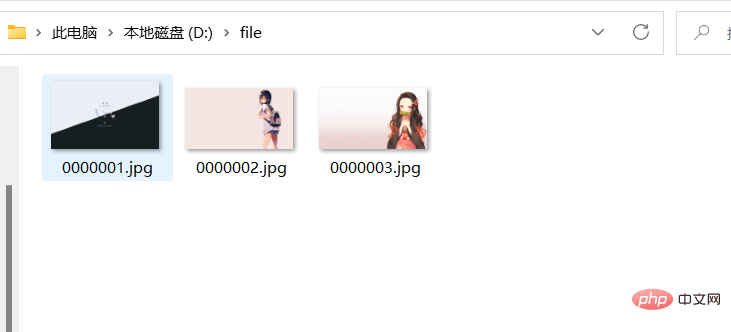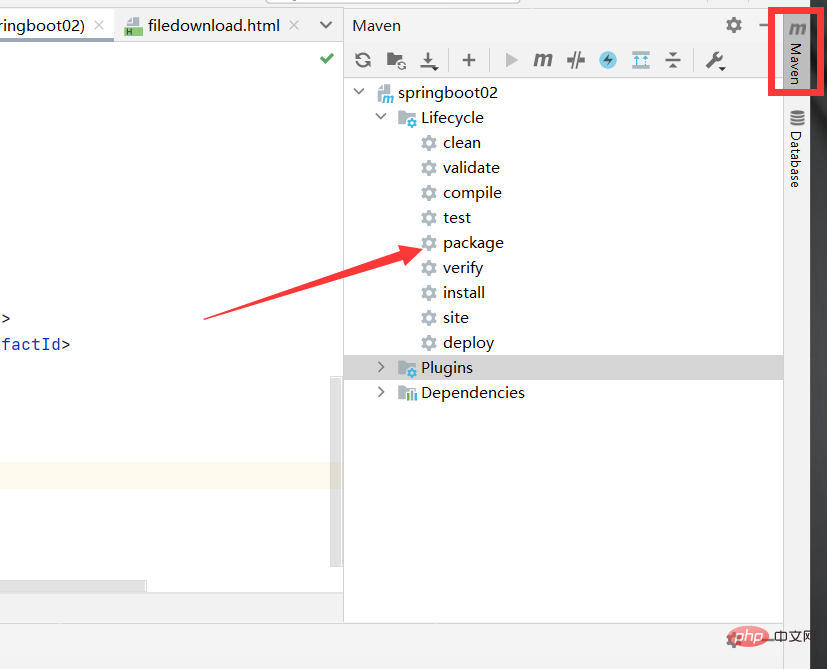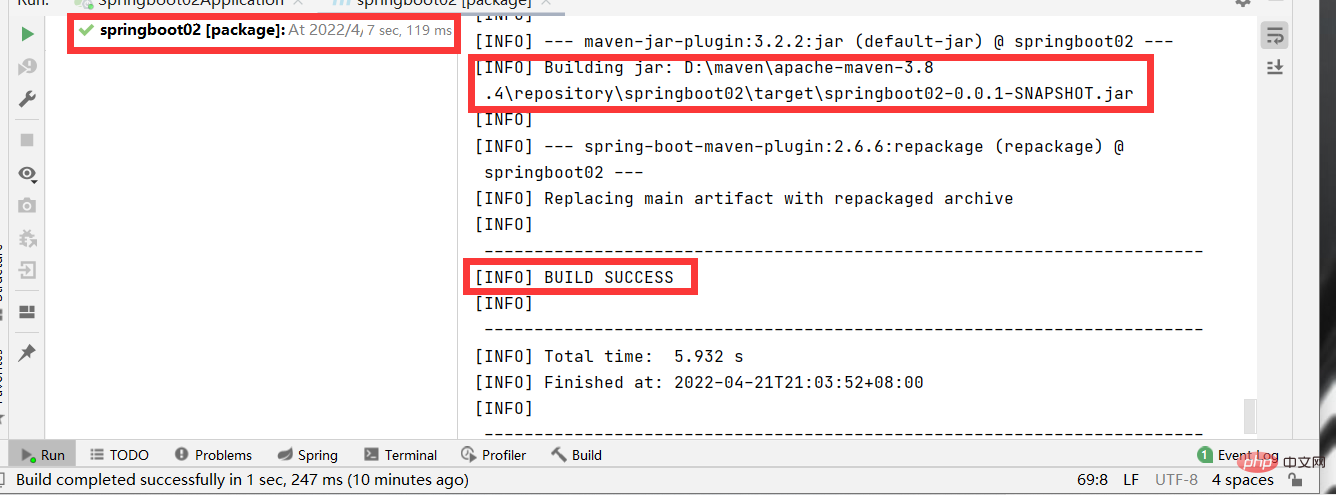SpringBoot가 WEB의 공통 기능을 구현하는 방법
- 王林앞으로
- 2023-05-12 14:37:131403검색
SpringMVC 통합 지원
웹 개발을 구현하고 단순화하기 위해 Spring Boot는 Spring MVC, Spring WebFlux 및 기타 프레임워크와 같이 일반적으로 사용되는 일부 웹 개발 프레임워크에 대한 통합 지원을 제공합니다. 웹 개발을 위해 Spring Boot를 사용하는 경우 웹 개발 프레임워크에 해당하는 종속성 시작자를 프로젝트에 도입하기만 하면 됩니다.
Spring MVC 자동 구성
Spring Boot 프로젝트에서 웹 종속성 스타터 spring-boot-starter-web이 도입되면 SpringBoot는 Spring MVC 프레임워크에 기본적으로 구현된 일부 xxxAutoConfiguration 자동 구성 클래스를 통합하고 자동으로 적용됩니다. 추가 구성 없이 거의 웹 개발이 가능합니다. Spring MVC 프레임워크를 통합하여 웹 개발을 구현하기 위해 Spring Boot는 주로 다음과 같은 자동화된 구성 기능을 제공합니다.
(1) 내장된 두 가지 뷰 확인자: ContentNegotatingViewResolver 및 BeanNameViewReso
(2) 정적 리소스 및 WebJars를 지원합니다.
(3) 변환기 및 포맷터는 자동으로 등록됩니다.
(4) Http 메시지 변환기를 지원합니다.
(5) 메시지 코드 파서는 자동으로 등록됩니다.
(6) 정적 프로젝트 홈페이지 index.html을 지원합니다.
(7) 사용자 정의 애플리케이션 아이콘 favicon.ico를 지원합니다.
(8) 웹 데이터 바인더 ConfigurableWebBindinglinitializer를 자동으로 초기화합니다.
Spring Boot는 Spring MVC를 통합하여 웹 개발을 위한 많은 기본 구성을 제공하며 대부분의 경우 기본 구성을 사용하면 개발 요구 사항을 충족할 수 있습니다. 예를 들어 Spring Boot가 웹 개발을 위해 Spring MVC를 통합하는 경우 외부 뷰 확인자를 구성할 필요가 없습니다.
Spring MVC 기능 확장 구현
Spring Boot는 Spring MVC를 통합하여 웹 개발을 위한 많은 자동화된 구성을 제공하지만 실제 개발에서는 개발자가 여전히 일부 기능을 확장하고 구현해야 합니다. 아래에서는 Spring Boot가 Spring MVC 프레임워크를 통합하여 웹 개발의 확장된 기능을 실현하는 방법을 설명하기 위해 특정 사례를 사용합니다.
프로젝트 기본 환경 구축
Spring Inifializr 메소드를 사용하여 springboot02라는 Spring Boot 프로젝트를 생성하고 웹 종속성 및 Thymeleaf 종속성을 가져옵니다.
이후 프로젝트를 시작하고 http://localhost:8080/에 접속합니다. 다음 인터페이스가 보이면 접속에 성공했다는 의미이며, 이는 프로젝트가 성공적으로 생성되었음을 의미합니다.

리소스 아래의 템플릿 패키지에 로그인 인터페이스 login.html을 생성합니다
<!DOCTYPE html>
<html>
<head>
<title>login</title>
</head>
<body>
<form>
<input type="text" name="username">
<input type="password" name="password">
<input type="submit" value="submit">
</form>
</body>
</html>마지막으로 com.hjk 패키지 아래에 컨트롤러 패키지를 생성하고 LoginController 클래스를 생성합니다.
package com.hjk.controller;
import org.springframework.stereotype.Controller;
import org.springframework.ui.Model;
import org.springframework.web.bind.annotation.GetMapping;
import java.util.Calendar;
@Controller
public class LoginController {
/**
* 获取并封装当前年份跳转到登录页login.html
*/
@GetMapping("/toLoginPage")
public String toLoginPage(Model model){
model.addAttribute("currentYear", Calendar.getInstance().get(Calendar.YEAR));
return "login";
}
}Function 확장 구현
다음에는 Spring Boot를 사용합니다. 웹 개발을 위해 Spring MVC를 통합하여 간단한 페이지 점프 기능을 구현합니다. 여기에서는 Spring Boot에서 제공하는 WebMvcConfigurer 인터페이스를 사용하여 사용자 정의 구성을 작성하고 웹 기능을 적절하게 확장합니다. 여기서는 뷰 관리자와 인터셉터의 구현을 각각 보여줍니다.
뷰 관리자를 등록하세요
springboot 프로젝트의 com.hjk 아래에 구성 패키지를 만들고 MVC 프레임워크 기능을 확장하는 데 사용되는 WebMvcConfigurer 인터페이스를 구현하는 구성 클래스 MyMVCconfig를 만듭니다.
package com.hjk.config;
import org.springframework.context.annotation.Configuration;
import org.springframework.web.servlet.config.annotation.InterceptorRegistry;
import org.springframework.web.servlet.config.annotation.ViewControllerRegistry;
import org.springframework.web.servlet.config.annotation.WebMvcConfigurer;
import javax.annotation.Resource;
@Configuration
public class MyMVCconfig implements WebMvcConfigurer {
@Override
public void addViewControllers(ViewControllerRegistry registry){
registry.addViewController("/toLoginPage").setViewName("login");
registry.addViewController("/login.html").setViewName("login");
}
}MMVCconig는 addViewControllerse를 구현합니다. 인터페이스 WebMvcConigurer(ViewControllerRegistry 레지스트리) 메소드의 addViewControllers() 메서드 내에서 ViewControllerRegistry의 addviewController() 메서드를 사용하여 각각 "tologinPage" 및 "login.html"의 요청 컨트롤을 정의하고 setViewName("login") 메서드를 사용하여 로그인에 대한 경로를 매핑합니다. HTML 페이지.
MVC의 뷰 관리 기능을 커스터마이징한 후
효과를 테스트해 볼 수 있습니다. 이 사용자 정의 효과를 보여주기 위해 Chapter05 프로젝트를 다시 시작합니다. http://localhost:8080/toLoginPage 및 http://localhost:8080/login.htm에 액세스하면 프로젝트가 성공적으로 시작됩니다.
WebMvcConfigurer 인터페이스에서 정의한 사용자 요청 제어 방법을 사용하면 기존 요청 처리 방법에 비해 사용자 요청 제어 점프 효과도 실현됩니다. 또한 이 방법을 사용하면 백그라운드에서 처리된 데이터를 얻을 수 없음을 알 수 있습니다. WebMvcConfigurer 인터페이스의 addViewControllers(ViewControllelRegistry 레지스트리) 메소드를 사용하여 보기 제어를 사용자 정의하는 것은 상대적으로 간단한 매개변수가 없는 보기 가져오기 요청에만 적합합니다. 비즈니스 처리가 필요한 매개변수 또는 점프 요구사항이 있는 경우 가장 좋습니다. 전통적인 방법을 사용합니다.
사용자 정의 인터셉터 등록
WebMvcConfigurer 인터페이스는 인터셉터 메서드 addInterceptors() 및 포맷터 메서드 addFormatters()를 포함하여 다양한 MVC 개발 관련 메서드를 제공합니다. 여기서는 인터셉터 메서드를 구현합니다.
config 패키지 아래에 사용자 정의 인터셉터 클래스 MyInterceptor를 생성합니다. 코드는 다음과 같습니다.
package com.hjk.config;
import org.springframework.stereotype.Component;
import org.springframework.web.servlet.HandlerInterceptor;
import org.springframework.web.servlet.ModelAndView;
import javax.servlet.http.HttpServletRequest;
import javax.servlet.http.HttpServletResponse;
import java.io.IOException;
import java.util.Calendar;
@Component
public class MyInterceptor implements HandlerInterceptor {
@Override
public boolean preHandle(HttpServletRequest request, HttpServletResponse response, Object handler) throws Exception {
String uri = request.getRequestURI();
Object loginUser = request.getSession().getAttribute("loginUser");
if (uri.startsWith("/admin")&& null==loginUser){
try {
response.sendRedirect("/toLoginPage");
} catch (IOException e) {
e.printStackTrace();
}
return false;
}
return true;
}
public void postHandle(HttpServletRequest request, HttpServletResponse response, Object handler, ModelAndView modelAndView) throws Exception {
System.out.println("拦截器拦截");
public void afterCompletion(HttpServletRequest request, HttpServletResponse response, Object handler, Exception ex) throws Exception {
}사용자 정의 인터셉터 클래스 Mylnterceptor는 HandlerInterceptor 인터페이스를 구현합니다. preHandle() 메소드에서는 사용자 요청이 "/admin"으로 시작하는 경우, 즉 http://localhost:8080/admin과 같은 주소에 접근할 때 사용자가 로그인되어 있는지 여부를 판단합니다. , 요청은 해당 로그인 페이지인 "hoLoginPage"로 리디렉션됩니다.
postHandle() 메소드에서 인터셉터 인터셉터를 콘솔에 인쇄합니다.
然后在config包下自定义配置类MyMVCconfig中,重写addlnterceptors()方法注册自定义的拦截器。添加以下代码。
@Autowired
private MyInterceptor myInterceptor;
@Override
public void addInterceptors(InterceptorRegistry registry) {
registry.addInterceptor(myInterceptor).addPathPatterns("/**").excludePathPatterns("/login.html");
}先使用@Autowired注解引入自定义的 Mylnterceptor拦截器组件,然后重写其中的 addinterceptors()方法注册自定义的拦截器。在注册自定义拦截器时,使用addPathPatterns("/**)方法拦截所有路径请求,excludePathPatterns("/login.htm")方法对“login.html”路径的请求进行了放行处理。
测试:我们可以访问http://localhost:8080/admin 可以发现它重定向大toLoginPage界面了。
Spring整合Servlet三大组件
在这里我们使用组件注册方式对Servlet、Filter、Listener三大组件进行整合,我们只需要将自定义的组件通过ServletRegistrationBean、FilterRegistrationBean、ServletListenerRegistrationBean类注册到容器中即可。
使用注册方式整合
使用组件注册方式整合Servlet
我们在com.hjk包下创建servletComponent的包,在该包下创建MyServlet类并继承HttpServlet类。
package com.hjk.servletCompont;
import org.springframework.stereotype.Component;
import javax.servlet.ServletException;
import javax.servlet.http.HttpServlet;
import javax.servlet.http.HttpServletRequest;
import javax.servlet.http.HttpServletResponse;
import java.io.IOException;
@Component
public class MyServlet extends HttpServlet {
@Override
protected void doGet(HttpServletRequest req, HttpServletResponse resp) throws ServletException, IOException {
super.doGet(req, resp);
}
protected void doPost(HttpServletRequest req, HttpServletResponse resp) throws ServletException, IOException {
resp.getWriter().write("hello MyServlet");
}@Component注解将MyServlet类作为组件注入Spring容器。MySeret类继承自HttpServlet,通过HttpServletResponse对象向页面输出“hello MyServlet”。
创建 Servlet组件配置类。在项目com.hjk.confg包下创建一个Servlet组件配置类servietConfig,用来对 Servlet相关组件进行注册,
package com.hjk.config;
import com.hjk.servletCompont.MyServlet;
import org.springframework.boot.web.servlet.ServletRegistrationBean;
import org.springframework.context.annotation.Bean;
import org.springframework.context.annotation.Configuration;
@Configuration
public class ServletConfig {
@Bean
public ServletRegistrationBean getServlet(MyServlet myServlet){
ServletRegistrationBean registrationBean = new ServletRegistrationBean(myServlet, "/myServlet");
return registrationBean;
}
}使用@Configuration 注解将ServletConfig标注为配置类,ServletConfig类内部的 getServlet()方法用于注册自定义的MyServlet,并返回 ServletRegistrationBean类型的Bean对象。
测试:项目启动成功后,在浏览器上访问“http://localhost:8080/myServlet"myServlet并正常显示数据,说明 Spring Boot成功整合Servlet组件。
使用组件注册方式整合Filter
在servletCompont包下创建一个MyFilter类并实现Filter接口,这个Filter的包别导错了
package com.hjk.servletCompont;
import org.springframework.stereotype.Component;
import javax.servlet.*;
import java.io.IOException;
@Component
public class MyFilter implements Filter {
@Override
public void init(FilterConfig filterConfig) throws ServletException {
}
public void doFilter(ServletRequest servletRequest, ServletResponse servletResponse, FilterChain filterChain) throws IOException, ServletException {
System.out.println("hello MyFilter");
public void destroy() {
}在config包下的ServletConfig类中进行注册,即在该类中添加方法。
@Bean
public FilterRegistrationBean getFilter(MyFilter myFilter){
FilterRegistrationBean filterRegistrationBean = new FilterRegistrationBean(myFilter);
filterRegistrationBean.setUrlPatterns(Arrays.asList("/toLogin","/myFilter"));
return filterRegistrationBean;
}使用 setUrilPatterns(Arrays.asList("/toLoginPage",/myFilter')方法定义了过滤的请求路径
“/toLoginPage”和“/myFilter”,同时使用@Bean 注解将当前组装好的FilterRegistrationBea对象作为Bean组件返回。
测试:在浏览器上访问“http://localhost:8080/myFilter”查看控制台打印效果(由于没有编写对应路径的请求处理方法,所以浏览器会出现404 错误页面,这里重点关注控制台即可),浏览器访问“http://localhost:8080/
myFilter”时,控制台打印出了自定义 Filter中定义 图5-6 使用组件注册方式整合Filter的运行结果的输出语句“hello MyFilter”,这也就说明Spring Boot 整合自定义Filter 组件成功。
使用组件注册方式整合 Listener
(1)创建自定义Listener类。在com.itheima.senleiComponent包下创建一个类MyListener实现ServletContextListener接口
package com.hjk.servletCompont;
import org.springframework.stereotype.Component;
import javax.servlet.ServletContextEvent;
import javax.servlet.ServletContextListener;
@Component
public class MyListener implements ServletContextListener {
@Override
public void contextInitialized(ServletContextEvent sce) {
System.out.println("contextnitialized...");
}
public void contextDestroyed(ServletContextEvent sce) {
System.out.println("contextDestroyed...");
}在servletConfig添加注册
@Bean
public ServletListenerRegistrationBean getServletListener(MyListener myListener){
ServletListenerRegistrationBean servletListenerRegistrationBean = new ServletListenerRegistrationBean(myListener);
return servletListenerRegistrationBean;
}需要说明的是,Servlet 容器提供了很多 Listener 接口,例如 ServletRequestListener、ritpSessionListener、ServletContextListener等,我们在自定义Listener类时要根据自身需求选择实现对应接口即可。
测试:程序启动成功后,控制台会打印出自定义Listener组件中定义的输出语句“contextlnitialized..”。单击图中的【Exit】按钮关闭当前项目(注意,如果直接单击红色按钮会强制关闭程序,浏览器就无法打印关闭监听信息),再次查看控制台打印效果。
程序成功关闭后,控制台打印出了自定义Listener组件中定义的输出语句“contextDestroyed..”。通过效果演示,说明了Spring Boot整合自定义Listener组件成功。
文件上传与下载
开发web应用时,文件上传是很常见的一个需求,浏览器通过表单形式将文件以流的形式传递给服务器,服务器在对上传的数据解析处理。
文件上传
编写上传表单界面
这个表单界面名为upload.html,在templates文件夹下
<!DOCTYPE html>
<html lang="en">
<head>
<meta charset="UTF-8">
<title>文件上传</title>
</head>
<body>
<div >
<form action="/uploadFile" method="post" enctype="multipart/form-data">
上传:<input type="file" name="filename"/>
<input type="submit" value="submit"/>
</form>
</div>
</body>
</html>我们通过表单上传文件,表单提交给uploadFile控制器,提交方式为post必须为这种方式,因为get上传比较少,必须包含enctype="multipart/form-data".
我们通过提交的地址也应该清楚,我们肯定会写一个uploadFile的控制器。
添加文件上传的相关配置
我们在application.properties文件中添加配置,上传文件的大小限制。
## 文件最大限制为10mb,默认为1mb spring.servlet.multipart.max-file-size=1MB
如果文件超过限制大小,会报错。
编写控制器
我们在com.hjk.controller包下船舰一个名为FileController的类,用于实现文件上传的控制器。
我们这个文件上传只是实现一个简单的文件上传,并没有考虑上传文件重名的情况,实际上重名的话会覆盖之前的文件。要实现文件上传,我们肯定要给它一个唯一名称这个可以使用uuid实现,这里也没考虑文件存放位置问题,都是我自己把地址写死了,这里我们就不实现了。
实现历程:写这个控制器的时候,我的代码是正确的,前端文件也能提交,但是后端获取的文件就是null,我也看了很多博客,有的说是没有注册multipartResolver这个Bean,有的说是版本问题等等,但是都没有解决。最后一个不经意的小细节导致了我这次的代码不能获取到文件。那就是我们有在(@RequestParam("filename") MultipartFile file)前面加@RequestParam这个注解。反正我的这个是加上之后就能用了,我的这个springboot版本是2.6.6.至于真正原因现在不想思考了,等以后遇到再改吧。
@RequestPara("filename")必须获取参数名为filename的file参数
@RequestParam()默认为必传属性,可以通过@RequestParam(required = false)设置为非必传。因为required值默认是true,所以默认必传
@RequestParam("filename")或者@RequestParam(value = "filename")指定参数名
@RequestParam(defaultValue = "0")指定参数默认值
package com.hjk.controller;
import org.springframework.stereotype.Controller;
import org.springframework.web.bind.annotation.*;
import org.springframework.web.multipart.MultipartFile;
import java.io.File;
import java.io.IOException;
@Controller
public class FileController {
@GetMapping("/toUpload")
public String toUpload(){
return "upload";
}
@RequestMapping(value = "/uploadFile",method = RequestMethod.POST)
public String uploadFile(@RequestParam("filename") MultipartFile file){
String filename = file.getOriginalFilename();
String dirPath = "D:/file/";
File filePath = new File(dirPath);
if (!filePath.exists()){
filePath.mkdir();
}
try {
file.transferTo(new File(dirPath+filename));
} catch (IOException e) {
e.printStackTrace();
}在这里我们提交三张图片用于下面的文件下载

文件下载
文件下载很多框架都没有进行封装处理,不同的浏览器解析处理不同,有可能出现乱码情况。
在添加完依赖之后我们创建一个名为filedownload.html的html,一会用于编写下载界面。
添加依赖
<dependency>
<groupId>commons-io</groupId>
<artifactId>commons-io</artifactId>
<version>2.6</version>
</dependency>下载处理控制器
我们还是再FileController类里添加下载处理方法。直接在里面添加就行。
@GetMapping("/toDownload")
public String toDownload(){
return "filedownload";
}
@GetMapping("/download")
public ResponseEntity<byte[]> fileDownload(String filename){
//指定下载地址文件路径
String dirPath = "D:/file/";
//创建文件下载对象
File file = new File(dirPath + File.separator + filename);
//设置响应头
HttpHeaders httpHeaders = new HttpHeaders();
//通知浏览器以下载方式打开
httpHeaders.setContentDispositionFormData("attachment",filename);
//定义以流的形式下载返回文件
httpHeaders.setContentType(MediaType.APPLICATION_OCTET_STREAM);
try {
return new ResponseEntity<>(FileUtils.readFileToByteArray(file),httpHeaders, HttpStatus.OK);
} catch (IOException e) {
e.printStackTrace();
return new ResponseEntity<byte[]>(e.getMessage().getBytes(), HttpStatus.EXPECTATION_FAILED);
}编写前端代码
<!DOCTYPE html>
<html lang="en" xmlns:th="http://www.thymeleaf.org">
<head>
<meta charset="UTF-8">
<title>文件下载</title>
</head>
<body>
<div >文件下载列表</div>
<table>
<tr>
<td>0000001.jpg</td>
<td><a th:href="@{/download(filename='0000001.jpg')}">下载文件</a> </td>
</tr>
<tr>
<td>0000002.jpg</td>
<td><a th:href="@{/download(filename='0000002.jpg')}">下载文件</a> </td>
</tr>
<tr>
<td>0000003.jpg</td>
<td><a th:href="@{/download(filename='0000003.jpg')}">下载文件</a> </td>
</tr>
</table>
</body>
</html>我们这次使用了thymeleaf写前端代码。
实际上我们可能会遇到下载中文文件的问题,那样可能会乱码。
我么在这里写一个解决中文乱码的例子。例如:我把0000001.jpg改为"你好jpg"再重新部署下载,会发现名字为_.jpg
下面我们直接在我们在fileController类的里面加一个getFileName方法,并修改fileDownload方法上做修改。
public String getFileName(HttpServletRequest request,String filename) throws Exception {
String[] IEBrowserKeyWords = {"MSIE","Trident","Edge"};
String userAgent = request.getHeader("User-Agent");
for (String ieBrowserKeyWord : IEBrowserKeyWords) {
if (userAgent.contains(ieBrowserKeyWord)){
return URLEncoder.encode(filename,"UTF-8").replace("+"," ");
}
}
return new String(filename.getBytes(StandardCharsets.UTF_8),"ISO-8859-1");
}
@GetMapping("/download")
public ResponseEntity<byte[]> fileDownload(HttpServletRequest request,String filename) throws Exception {
//指定下载地址文件路径
String dirPath = "D:/file/";
//创建文件下载对象
File file = new File(dirPath + File.separator + filename);
//设置响应头
HttpHeaders httpHeaders = new HttpHeaders();
//通知浏览器下载七千及性能转码
filename = getFileName(request,filename);
//通知浏览器以下载方式打开
httpHeaders.setContentDispositionFormData("attachment",filename);
//定义以流的形式下载返回文件
httpHeaders.setContentType(MediaType.APPLICATION_OCTET_STREAM);
try {
return new ResponseEntity<>(FileUtils.readFileToByteArray(file),httpHeaders, HttpStatus.OK);
} catch (IOException e) {
e.printStackTrace();
return new ResponseEntity<byte[]>(e.getMessage().getBytes(), HttpStatus.EXPECTATION_FAILED);SpringBoot的打包部署
springboot使用的嵌入式Servlet容器,所以默认是以jar包打包的。也可以进行war包打包,但是需要进行一些配置。
jar包形式打包
我们在创建springboot项目是默认会给我们导入maven的打包插件,如果没有我们手动加上即可。
<build>
<plugins>
<plugin>
<groupId>org.springframework.boot</groupId>
<artifactId>spring-boot-maven-plugin</artifactId>
</plugin>
</plugins>
</build>双击package等待即可

等待完成,可以看到打包时间,存放jar包位置等信息。我们也可以在target包下查看打成的jar包。

启动jar包
我们可以在关闭已启动的springboot项目后,在idea控制台输入命令启动。
java -jar target\springboot02-0.0.1-SNAPSHOT.jar
我们也可以在系统自带的终端窗口启动
war包形式打包
我们首先要把默认打包方式修改为war包
<name>springboot02</name>
<description>Demo project for Spring Boot</description>
<packaging>war</packaging>
<properties>
<java.version>1.8</java.version>
</properties>导入外部Tomcat服务器
<dependency>
<groupId>org.springframework.boot</groupId>
<artifactId>spring-boot-starter-tomcat</artifactId>
<scope>provided</scope>
</dependency>打开启动类,继承springbootServletInitializer类
package com.hjk;
import org.springframework.boot.SpringApplication;
import org.springframework.boot.autoconfigure.SpringBootApplication;
import org.springframework.boot.builder.SpringApplicationBuilder;
import org.springframework.boot.web.servlet.ServletComponentScan;
import org.springframework.boot.web.servlet.support.SpringBootServletInitializer;
@ServletComponentScan
@SpringBootApplication
public class Springboot02Application extends SpringBootServletInitializer {
public static void main(String[] args) {
SpringApplication.run(Springboot02Application.class, args);
}
@Override
protected SpringApplicationBuilder configure(SpringApplicationBuilder builder) {
return builder.sources(Springboot02Application.class);
}
}然后就和jar包方式一样了,双击package,等待打包完成。
war包的部署
war包的部署相比于jar包比较麻烦,我们需要外部的服务器,我们需要把war包复制到tomcat安装目录下的webapps目录中,执行目录里的startup.bat命令启动war包,这样我们就完成了。
위 내용은 SpringBoot가 WEB의 공통 기능을 구현하는 방법의 상세 내용입니다. 자세한 내용은 PHP 중국어 웹사이트의 기타 관련 기사를 참조하세요!

